Selecting a Distribution Strategy to Achieve Supply Chain Goals
VerifiedAdded on 2022/09/17
|10
|2677
|28
Report
AI Summary
This report provides an overview of distribution strategies within supply chain management, addressing their significance in achieving corporate objectives. It discusses various distribution methods, including direct and indirect distribution, intensive, selective, and exclusive strategies, and examines their suitability for different competitive scenarios. The report highlights the importance of aligning distribution strategies with factors such as product type, customer base, and technological advancements like automation and cloud-based systems. It emphasizes the need for adaptive and agile supply chains capable of responding to market opportunities and risks, ultimately stressing that the best distribution strategy depends on a thorough analysis of expenses, time consumption, and the adoption of demand-driven planning models. The document is available on Desklib, a platform offering study tools and solved assignments for students.

Distribution strategy
Paraphrase This Document
Need a fresh take? Get an instant paraphrase of this document with our AI Paraphraser

Contents
Introduction......................................................................................................................................2
Distribution strategy........................................................................................................................2
Conclusion.......................................................................................................................................7
Reference.........................................................................................................................................8
Introduction......................................................................................................................................2
Distribution strategy........................................................................................................................2
Conclusion.......................................................................................................................................7
Reference.........................................................................................................................................8
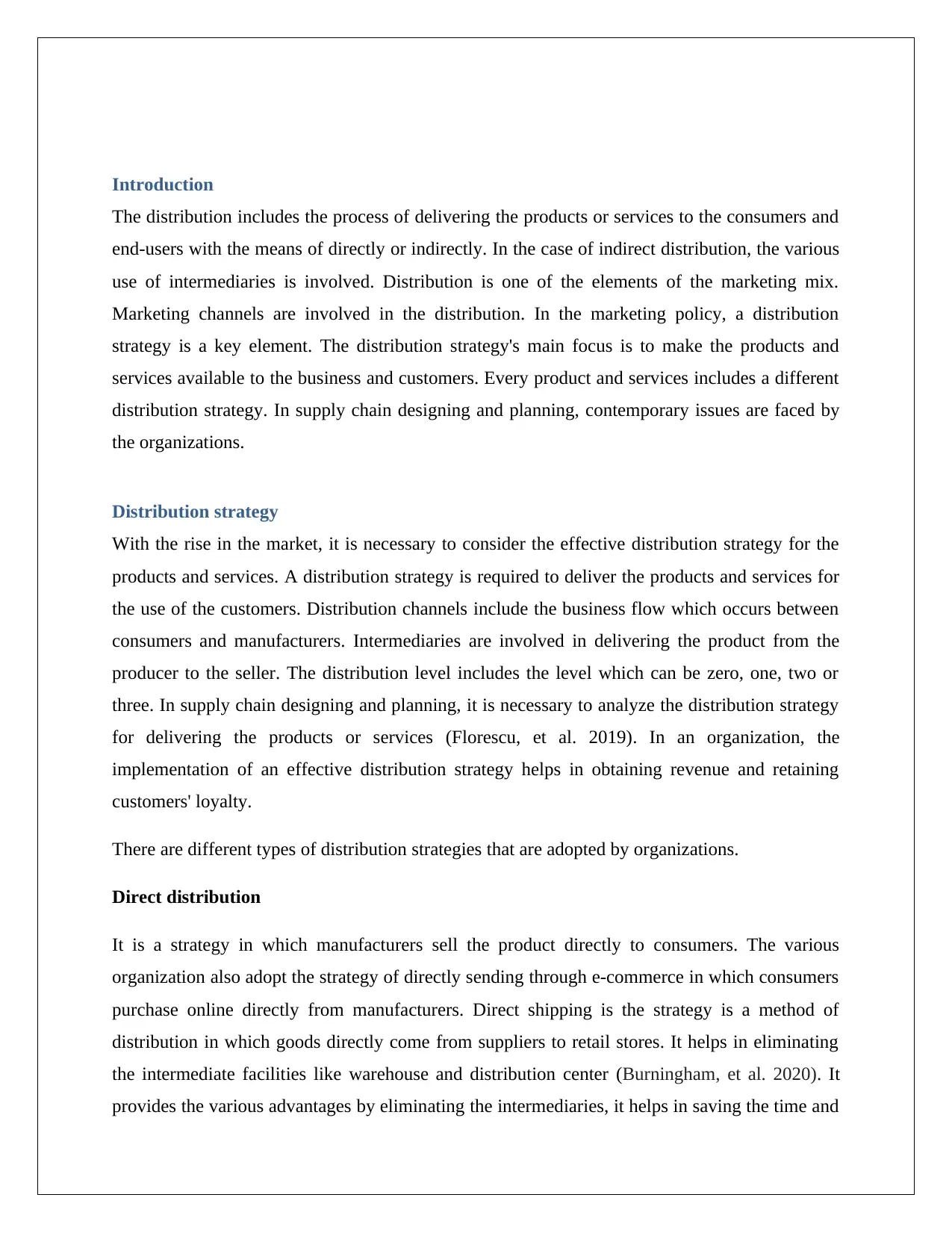
Introduction
The distribution includes the process of delivering the products or services to the consumers and
end-users with the means of directly or indirectly. In the case of indirect distribution, the various
use of intermediaries is involved. Distribution is one of the elements of the marketing mix.
Marketing channels are involved in the distribution. In the marketing policy, a distribution
strategy is a key element. The distribution strategy's main focus is to make the products and
services available to the business and customers. Every product and services includes a different
distribution strategy. In supply chain designing and planning, contemporary issues are faced by
the organizations.
Distribution strategy
With the rise in the market, it is necessary to consider the effective distribution strategy for the
products and services. A distribution strategy is required to deliver the products and services for
the use of the customers. Distribution channels include the business flow which occurs between
consumers and manufacturers. Intermediaries are involved in delivering the product from the
producer to the seller. The distribution level includes the level which can be zero, one, two or
three. In supply chain designing and planning, it is necessary to analyze the distribution strategy
for delivering the products or services (Florescu, et al. 2019). In an organization, the
implementation of an effective distribution strategy helps in obtaining revenue and retaining
customers' loyalty.
There are different types of distribution strategies that are adopted by organizations.
Direct distribution
It is a strategy in which manufacturers sell the product directly to consumers. The various
organization also adopt the strategy of directly sending through e-commerce in which consumers
purchase online directly from manufacturers. Direct shipping is the strategy is a method of
distribution in which goods directly come from suppliers to retail stores. It helps in eliminating
the intermediate facilities like warehouse and distribution center (Burningham, et al. 2020). It
provides the various advantages by eliminating the intermediaries, it helps in saving the time and
The distribution includes the process of delivering the products or services to the consumers and
end-users with the means of directly or indirectly. In the case of indirect distribution, the various
use of intermediaries is involved. Distribution is one of the elements of the marketing mix.
Marketing channels are involved in the distribution. In the marketing policy, a distribution
strategy is a key element. The distribution strategy's main focus is to make the products and
services available to the business and customers. Every product and services includes a different
distribution strategy. In supply chain designing and planning, contemporary issues are faced by
the organizations.
Distribution strategy
With the rise in the market, it is necessary to consider the effective distribution strategy for the
products and services. A distribution strategy is required to deliver the products and services for
the use of the customers. Distribution channels include the business flow which occurs between
consumers and manufacturers. Intermediaries are involved in delivering the product from the
producer to the seller. The distribution level includes the level which can be zero, one, two or
three. In supply chain designing and planning, it is necessary to analyze the distribution strategy
for delivering the products or services (Florescu, et al. 2019). In an organization, the
implementation of an effective distribution strategy helps in obtaining revenue and retaining
customers' loyalty.
There are different types of distribution strategies that are adopted by organizations.
Direct distribution
It is a strategy in which manufacturers sell the product directly to consumers. The various
organization also adopt the strategy of directly sending through e-commerce in which consumers
purchase online directly from manufacturers. Direct shipping is the strategy is a method of
distribution in which goods directly come from suppliers to retail stores. It helps in eliminating
the intermediate facilities like warehouse and distribution center (Burningham, et al. 2020). It
provides the various advantages by eliminating the intermediaries, it helps in saving the time and
⊘ This is a preview!⊘
Do you want full access?
Subscribe today to unlock all pages.

Trusted by 1+ million students worldwide
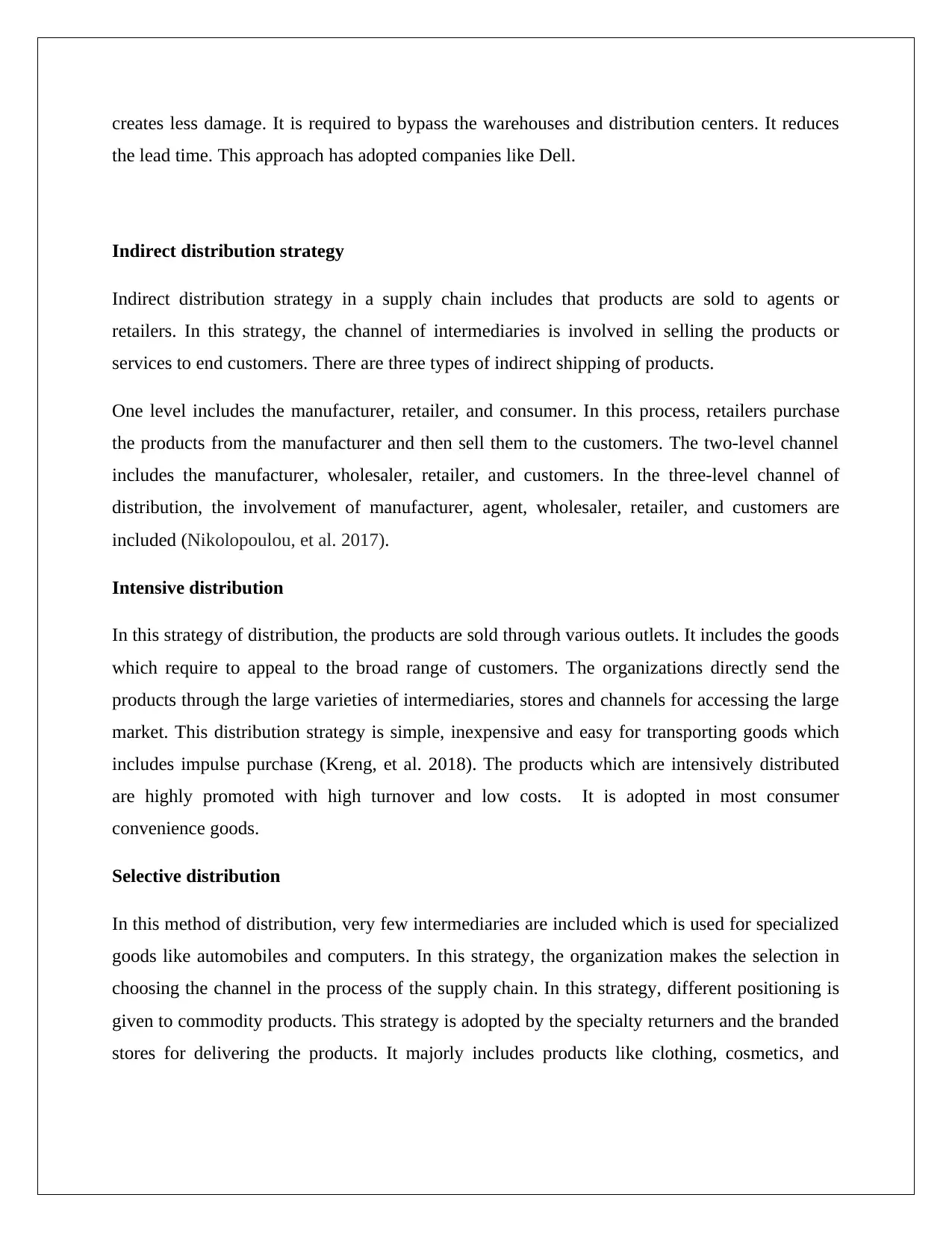
creates less damage. It is required to bypass the warehouses and distribution centers. It reduces
the lead time. This approach has adopted companies like Dell.
Indirect distribution strategy
Indirect distribution strategy in a supply chain includes that products are sold to agents or
retailers. In this strategy, the channel of intermediaries is involved in selling the products or
services to end customers. There are three types of indirect shipping of products.
One level includes the manufacturer, retailer, and consumer. In this process, retailers purchase
the products from the manufacturer and then sell them to the customers. The two-level channel
includes the manufacturer, wholesaler, retailer, and customers. In the three-level channel of
distribution, the involvement of manufacturer, agent, wholesaler, retailer, and customers are
included (Nikolopoulou, et al. 2017).
Intensive distribution
In this strategy of distribution, the products are sold through various outlets. It includes the goods
which require to appeal to the broad range of customers. The organizations directly send the
products through the large varieties of intermediaries, stores and channels for accessing the large
market. This distribution strategy is simple, inexpensive and easy for transporting goods which
includes impulse purchase (Kreng, et al. 2018). The products which are intensively distributed
are highly promoted with high turnover and low costs. It is adopted in most consumer
convenience goods.
Selective distribution
In this method of distribution, very few intermediaries are included which is used for specialized
goods like automobiles and computers. In this strategy, the organization makes the selection in
choosing the channel in the process of the supply chain. In this strategy, different positioning is
given to commodity products. This strategy is adopted by the specialty returners and the branded
stores for delivering the products. It majorly includes products like clothing, cosmetics, and
the lead time. This approach has adopted companies like Dell.
Indirect distribution strategy
Indirect distribution strategy in a supply chain includes that products are sold to agents or
retailers. In this strategy, the channel of intermediaries is involved in selling the products or
services to end customers. There are three types of indirect shipping of products.
One level includes the manufacturer, retailer, and consumer. In this process, retailers purchase
the products from the manufacturer and then sell them to the customers. The two-level channel
includes the manufacturer, wholesaler, retailer, and customers. In the three-level channel of
distribution, the involvement of manufacturer, agent, wholesaler, retailer, and customers are
included (Nikolopoulou, et al. 2017).
Intensive distribution
In this strategy of distribution, the products are sold through various outlets. It includes the goods
which require to appeal to the broad range of customers. The organizations directly send the
products through the large varieties of intermediaries, stores and channels for accessing the large
market. This distribution strategy is simple, inexpensive and easy for transporting goods which
includes impulse purchase (Kreng, et al. 2018). The products which are intensively distributed
are highly promoted with high turnover and low costs. It is adopted in most consumer
convenience goods.
Selective distribution
In this method of distribution, very few intermediaries are included which is used for specialized
goods like automobiles and computers. In this strategy, the organization makes the selection in
choosing the channel in the process of the supply chain. In this strategy, different positioning is
given to commodity products. This strategy is adopted by the specialty returners and the branded
stores for delivering the products. It majorly includes products like clothing, cosmetics, and
Paraphrase This Document
Need a fresh take? Get an instant paraphrase of this document with our AI Paraphraser
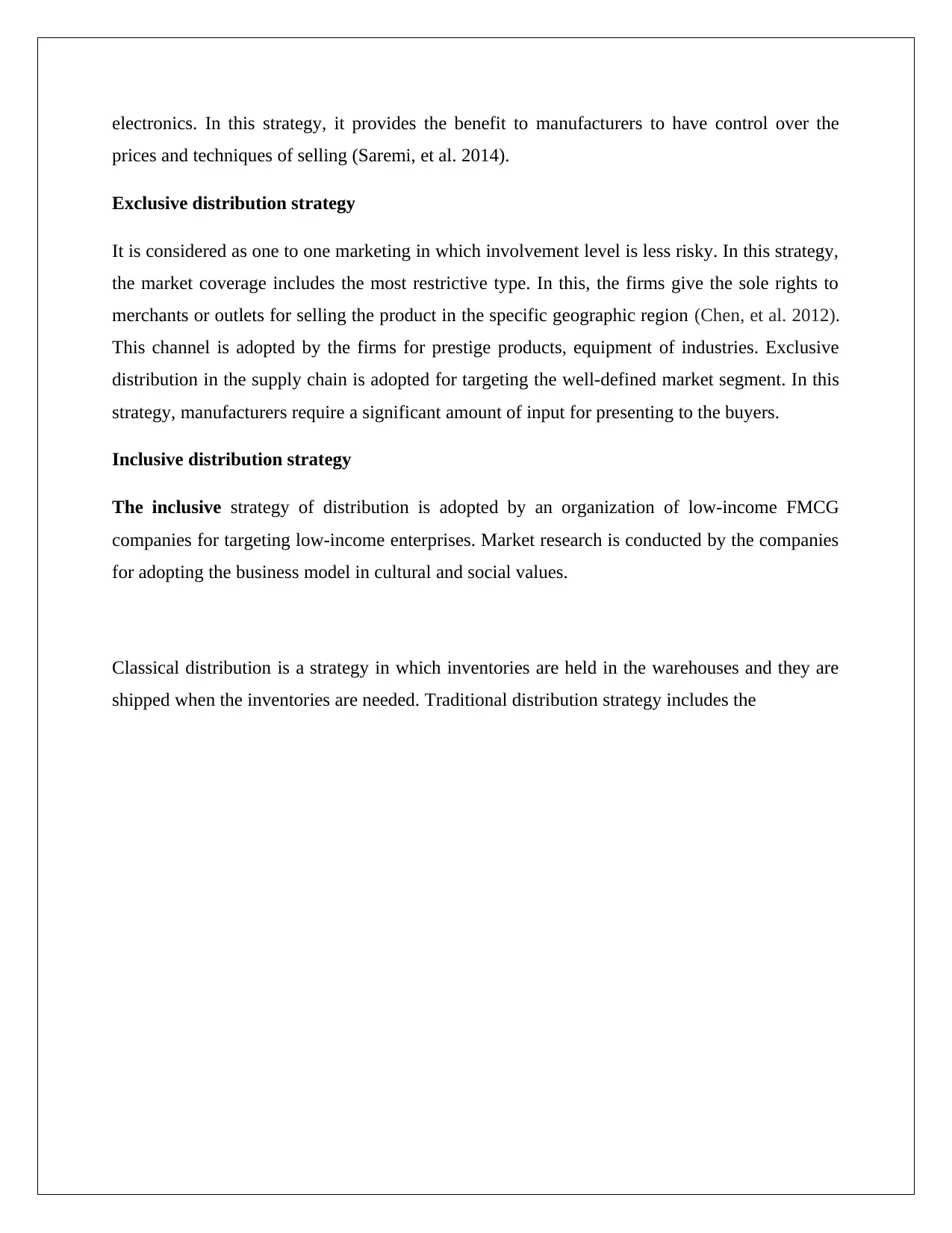
electronics. In this strategy, it provides the benefit to manufacturers to have control over the
prices and techniques of selling (Saremi, et al. 2014).
Exclusive distribution strategy
It is considered as one to one marketing in which involvement level is less risky. In this strategy,
the market coverage includes the most restrictive type. In this, the firms give the sole rights to
merchants or outlets for selling the product in the specific geographic region (Chen, et al. 2012).
This channel is adopted by the firms for prestige products, equipment of industries. Exclusive
distribution in the supply chain is adopted for targeting the well-defined market segment. In this
strategy, manufacturers require a significant amount of input for presenting to the buyers.
Inclusive distribution strategy
The inclusive strategy of distribution is adopted by an organization of low-income FMCG
companies for targeting low-income enterprises. Market research is conducted by the companies
for adopting the business model in cultural and social values.
Classical distribution is a strategy in which inventories are held in the warehouses and they are
shipped when the inventories are needed. Traditional distribution strategy includes the
prices and techniques of selling (Saremi, et al. 2014).
Exclusive distribution strategy
It is considered as one to one marketing in which involvement level is less risky. In this strategy,
the market coverage includes the most restrictive type. In this, the firms give the sole rights to
merchants or outlets for selling the product in the specific geographic region (Chen, et al. 2012).
This channel is adopted by the firms for prestige products, equipment of industries. Exclusive
distribution in the supply chain is adopted for targeting the well-defined market segment. In this
strategy, manufacturers require a significant amount of input for presenting to the buyers.
Inclusive distribution strategy
The inclusive strategy of distribution is adopted by an organization of low-income FMCG
companies for targeting low-income enterprises. Market research is conducted by the companies
for adopting the business model in cultural and social values.
Classical distribution is a strategy in which inventories are held in the warehouses and they are
shipped when the inventories are needed. Traditional distribution strategy includes the
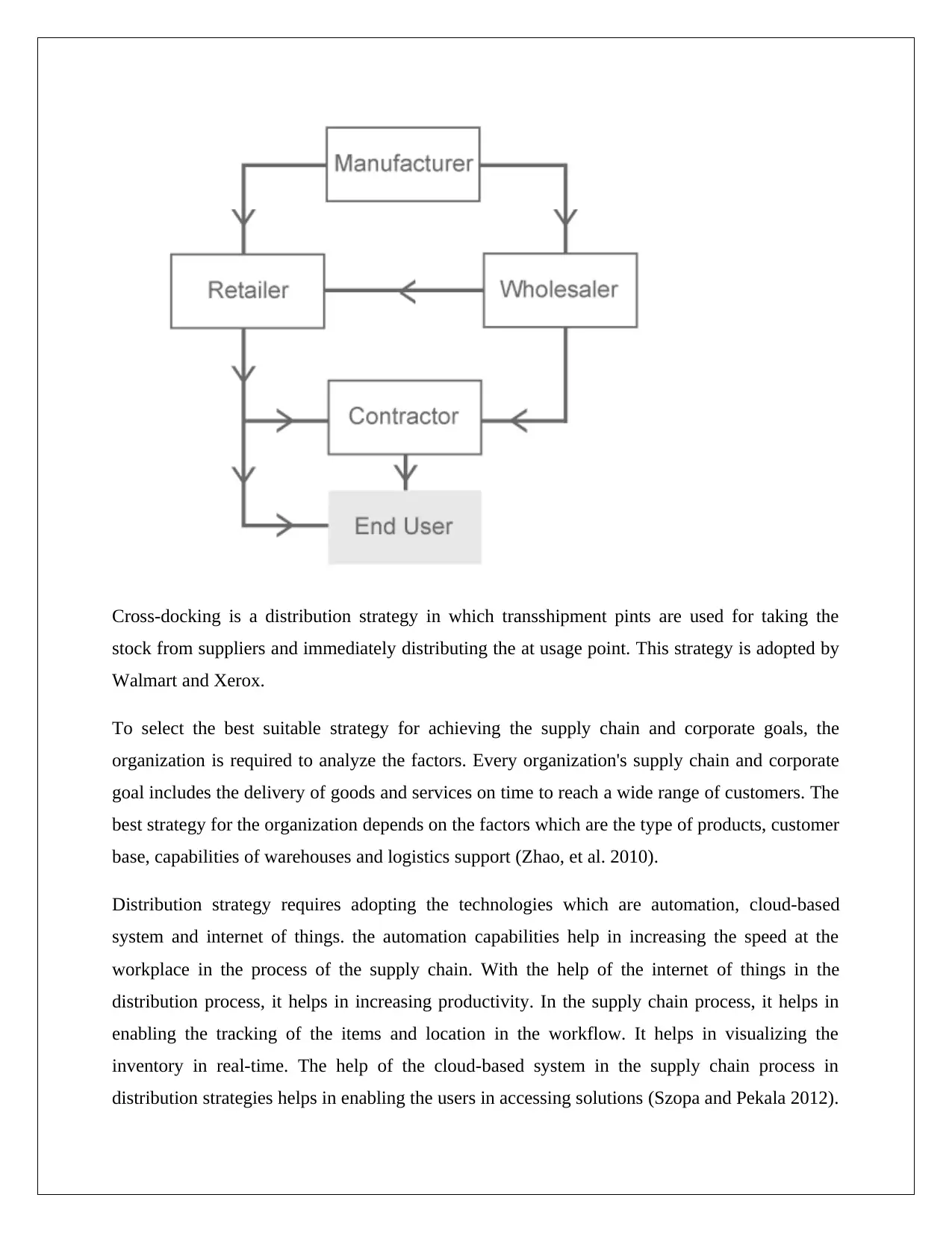
Cross-docking is a distribution strategy in which transshipment pints are used for taking the
stock from suppliers and immediately distributing the at usage point. This strategy is adopted by
Walmart and Xerox.
To select the best suitable strategy for achieving the supply chain and corporate goals, the
organization is required to analyze the factors. Every organization's supply chain and corporate
goal includes the delivery of goods and services on time to reach a wide range of customers. The
best strategy for the organization depends on the factors which are the type of products, customer
base, capabilities of warehouses and logistics support (Zhao, et al. 2010).
Distribution strategy requires adopting the technologies which are automation, cloud-based
system and internet of things. the automation capabilities help in increasing the speed at the
workplace in the process of the supply chain. With the help of the internet of things in the
distribution process, it helps in increasing productivity. In the supply chain process, it helps in
enabling the tracking of the items and location in the workflow. It helps in visualizing the
inventory in real-time. The help of the cloud-based system in the supply chain process in
distribution strategies helps in enabling the users in accessing solutions (Szopa and Pekala 2012).
stock from suppliers and immediately distributing the at usage point. This strategy is adopted by
Walmart and Xerox.
To select the best suitable strategy for achieving the supply chain and corporate goals, the
organization is required to analyze the factors. Every organization's supply chain and corporate
goal includes the delivery of goods and services on time to reach a wide range of customers. The
best strategy for the organization depends on the factors which are the type of products, customer
base, capabilities of warehouses and logistics support (Zhao, et al. 2010).
Distribution strategy requires adopting the technologies which are automation, cloud-based
system and internet of things. the automation capabilities help in increasing the speed at the
workplace in the process of the supply chain. With the help of the internet of things in the
distribution process, it helps in increasing productivity. In the supply chain process, it helps in
enabling the tracking of the items and location in the workflow. It helps in visualizing the
inventory in real-time. The help of the cloud-based system in the supply chain process in
distribution strategies helps in enabling the users in accessing solutions (Szopa and Pekala 2012).
⊘ This is a preview!⊘
Do you want full access?
Subscribe today to unlock all pages.

Trusted by 1+ million students worldwide
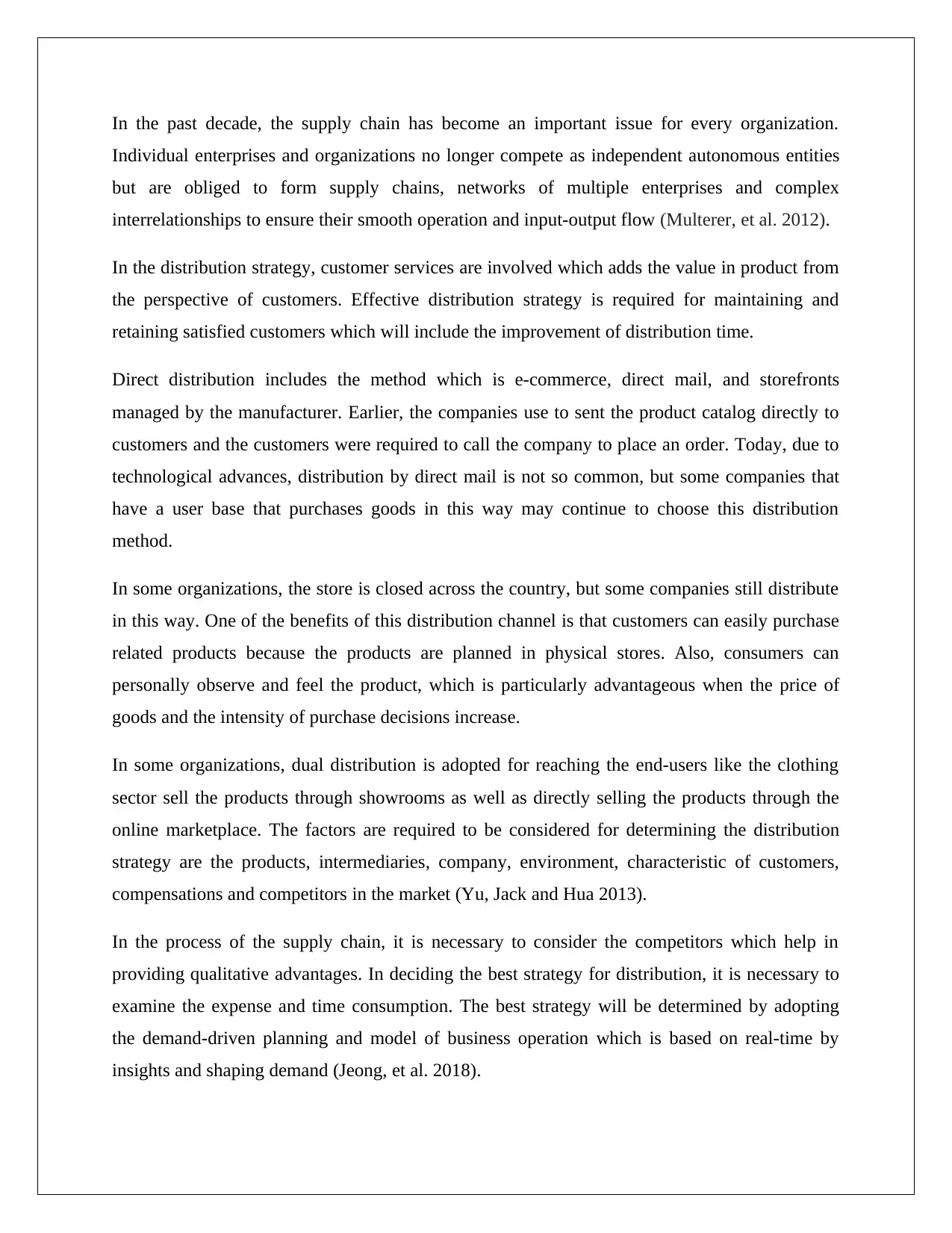
In the past decade, the supply chain has become an important issue for every organization.
Individual enterprises and organizations no longer compete as independent autonomous entities
but are obliged to form supply chains, networks of multiple enterprises and complex
interrelationships to ensure their smooth operation and input-output flow (Multerer, et al. 2012).
In the distribution strategy, customer services are involved which adds the value in product from
the perspective of customers. Effective distribution strategy is required for maintaining and
retaining satisfied customers which will include the improvement of distribution time.
Direct distribution includes the method which is e-commerce, direct mail, and storefronts
managed by the manufacturer. Earlier, the companies use to sent the product catalog directly to
customers and the customers were required to call the company to place an order. Today, due to
technological advances, distribution by direct mail is not so common, but some companies that
have a user base that purchases goods in this way may continue to choose this distribution
method.
In some organizations, the store is closed across the country, but some companies still distribute
in this way. One of the benefits of this distribution channel is that customers can easily purchase
related products because the products are planned in physical stores. Also, consumers can
personally observe and feel the product, which is particularly advantageous when the price of
goods and the intensity of purchase decisions increase.
In some organizations, dual distribution is adopted for reaching the end-users like the clothing
sector sell the products through showrooms as well as directly selling the products through the
online marketplace. The factors are required to be considered for determining the distribution
strategy are the products, intermediaries, company, environment, characteristic of customers,
compensations and competitors in the market (Yu, Jack and Hua 2013).
In the process of the supply chain, it is necessary to consider the competitors which help in
providing qualitative advantages. In deciding the best strategy for distribution, it is necessary to
examine the expense and time consumption. The best strategy will be determined by adopting
the demand-driven planning and model of business operation which is based on real-time by
insights and shaping demand (Jeong, et al. 2018).
Individual enterprises and organizations no longer compete as independent autonomous entities
but are obliged to form supply chains, networks of multiple enterprises and complex
interrelationships to ensure their smooth operation and input-output flow (Multerer, et al. 2012).
In the distribution strategy, customer services are involved which adds the value in product from
the perspective of customers. Effective distribution strategy is required for maintaining and
retaining satisfied customers which will include the improvement of distribution time.
Direct distribution includes the method which is e-commerce, direct mail, and storefronts
managed by the manufacturer. Earlier, the companies use to sent the product catalog directly to
customers and the customers were required to call the company to place an order. Today, due to
technological advances, distribution by direct mail is not so common, but some companies that
have a user base that purchases goods in this way may continue to choose this distribution
method.
In some organizations, the store is closed across the country, but some companies still distribute
in this way. One of the benefits of this distribution channel is that customers can easily purchase
related products because the products are planned in physical stores. Also, consumers can
personally observe and feel the product, which is particularly advantageous when the price of
goods and the intensity of purchase decisions increase.
In some organizations, dual distribution is adopted for reaching the end-users like the clothing
sector sell the products through showrooms as well as directly selling the products through the
online marketplace. The factors are required to be considered for determining the distribution
strategy are the products, intermediaries, company, environment, characteristic of customers,
compensations and competitors in the market (Yu, Jack and Hua 2013).
In the process of the supply chain, it is necessary to consider the competitors which help in
providing qualitative advantages. In deciding the best strategy for distribution, it is necessary to
examine the expense and time consumption. The best strategy will be determined by adopting
the demand-driven planning and model of business operation which is based on real-time by
insights and shaping demand (Jeong, et al. 2018).
Paraphrase This Document
Need a fresh take? Get an instant paraphrase of this document with our AI Paraphraser
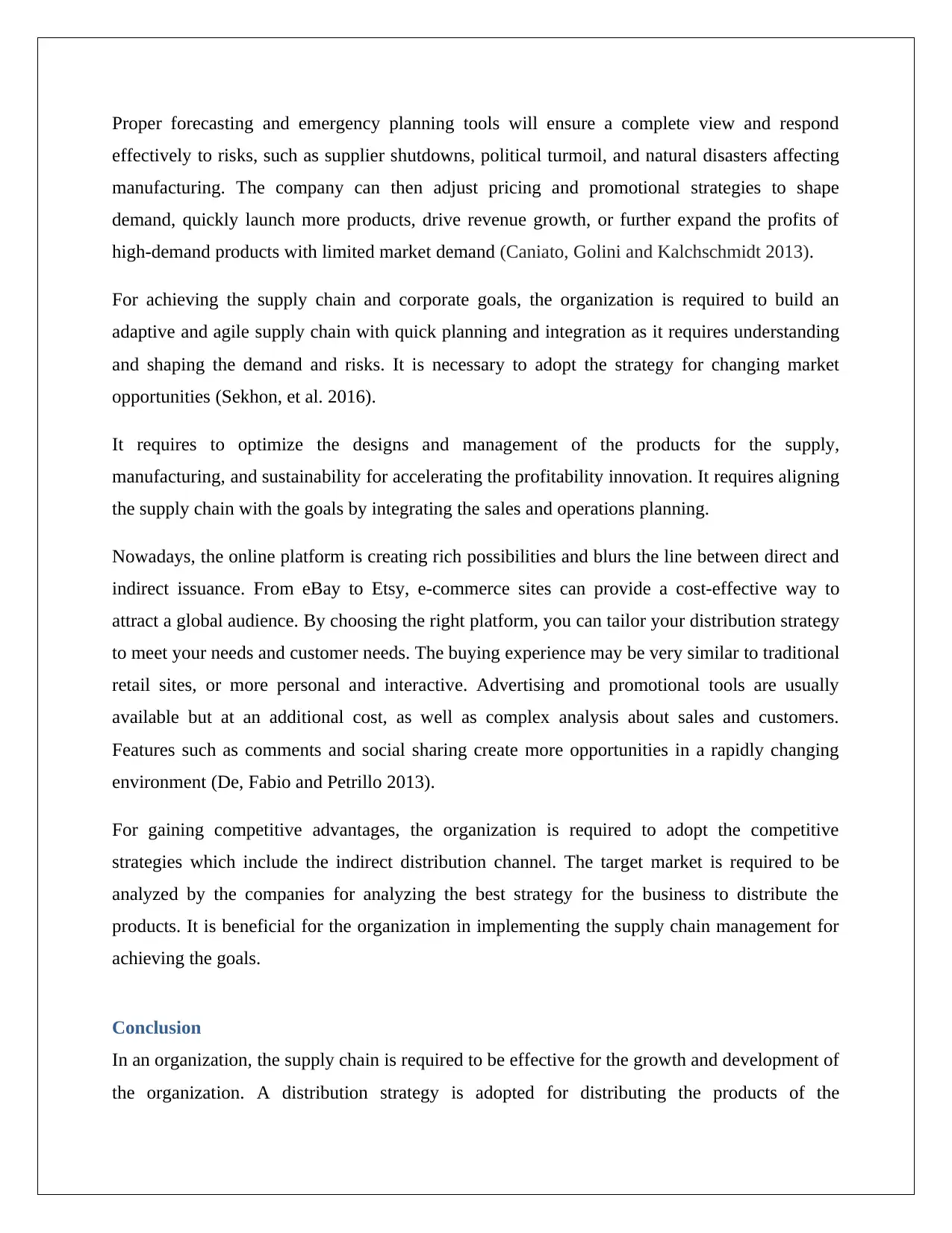
Proper forecasting and emergency planning tools will ensure a complete view and respond
effectively to risks, such as supplier shutdowns, political turmoil, and natural disasters affecting
manufacturing. The company can then adjust pricing and promotional strategies to shape
demand, quickly launch more products, drive revenue growth, or further expand the profits of
high-demand products with limited market demand (Caniato, Golini and Kalchschmidt 2013).
For achieving the supply chain and corporate goals, the organization is required to build an
adaptive and agile supply chain with quick planning and integration as it requires understanding
and shaping the demand and risks. It is necessary to adopt the strategy for changing market
opportunities (Sekhon, et al. 2016).
It requires to optimize the designs and management of the products for the supply,
manufacturing, and sustainability for accelerating the profitability innovation. It requires aligning
the supply chain with the goals by integrating the sales and operations planning.
Nowadays, the online platform is creating rich possibilities and blurs the line between direct and
indirect issuance. From eBay to Etsy, e-commerce sites can provide a cost-effective way to
attract a global audience. By choosing the right platform, you can tailor your distribution strategy
to meet your needs and customer needs. The buying experience may be very similar to traditional
retail sites, or more personal and interactive. Advertising and promotional tools are usually
available but at an additional cost, as well as complex analysis about sales and customers.
Features such as comments and social sharing create more opportunities in a rapidly changing
environment (De, Fabio and Petrillo 2013).
For gaining competitive advantages, the organization is required to adopt the competitive
strategies which include the indirect distribution channel. The target market is required to be
analyzed by the companies for analyzing the best strategy for the business to distribute the
products. It is beneficial for the organization in implementing the supply chain management for
achieving the goals.
Conclusion
In an organization, the supply chain is required to be effective for the growth and development of
the organization. A distribution strategy is adopted for distributing the products of the
effectively to risks, such as supplier shutdowns, political turmoil, and natural disasters affecting
manufacturing. The company can then adjust pricing and promotional strategies to shape
demand, quickly launch more products, drive revenue growth, or further expand the profits of
high-demand products with limited market demand (Caniato, Golini and Kalchschmidt 2013).
For achieving the supply chain and corporate goals, the organization is required to build an
adaptive and agile supply chain with quick planning and integration as it requires understanding
and shaping the demand and risks. It is necessary to adopt the strategy for changing market
opportunities (Sekhon, et al. 2016).
It requires to optimize the designs and management of the products for the supply,
manufacturing, and sustainability for accelerating the profitability innovation. It requires aligning
the supply chain with the goals by integrating the sales and operations planning.
Nowadays, the online platform is creating rich possibilities and blurs the line between direct and
indirect issuance. From eBay to Etsy, e-commerce sites can provide a cost-effective way to
attract a global audience. By choosing the right platform, you can tailor your distribution strategy
to meet your needs and customer needs. The buying experience may be very similar to traditional
retail sites, or more personal and interactive. Advertising and promotional tools are usually
available but at an additional cost, as well as complex analysis about sales and customers.
Features such as comments and social sharing create more opportunities in a rapidly changing
environment (De, Fabio and Petrillo 2013).
For gaining competitive advantages, the organization is required to adopt the competitive
strategies which include the indirect distribution channel. The target market is required to be
analyzed by the companies for analyzing the best strategy for the business to distribute the
products. It is beneficial for the organization in implementing the supply chain management for
achieving the goals.
Conclusion
In an organization, the supply chain is required to be effective for the growth and development of
the organization. A distribution strategy is adopted for distributing the products of the
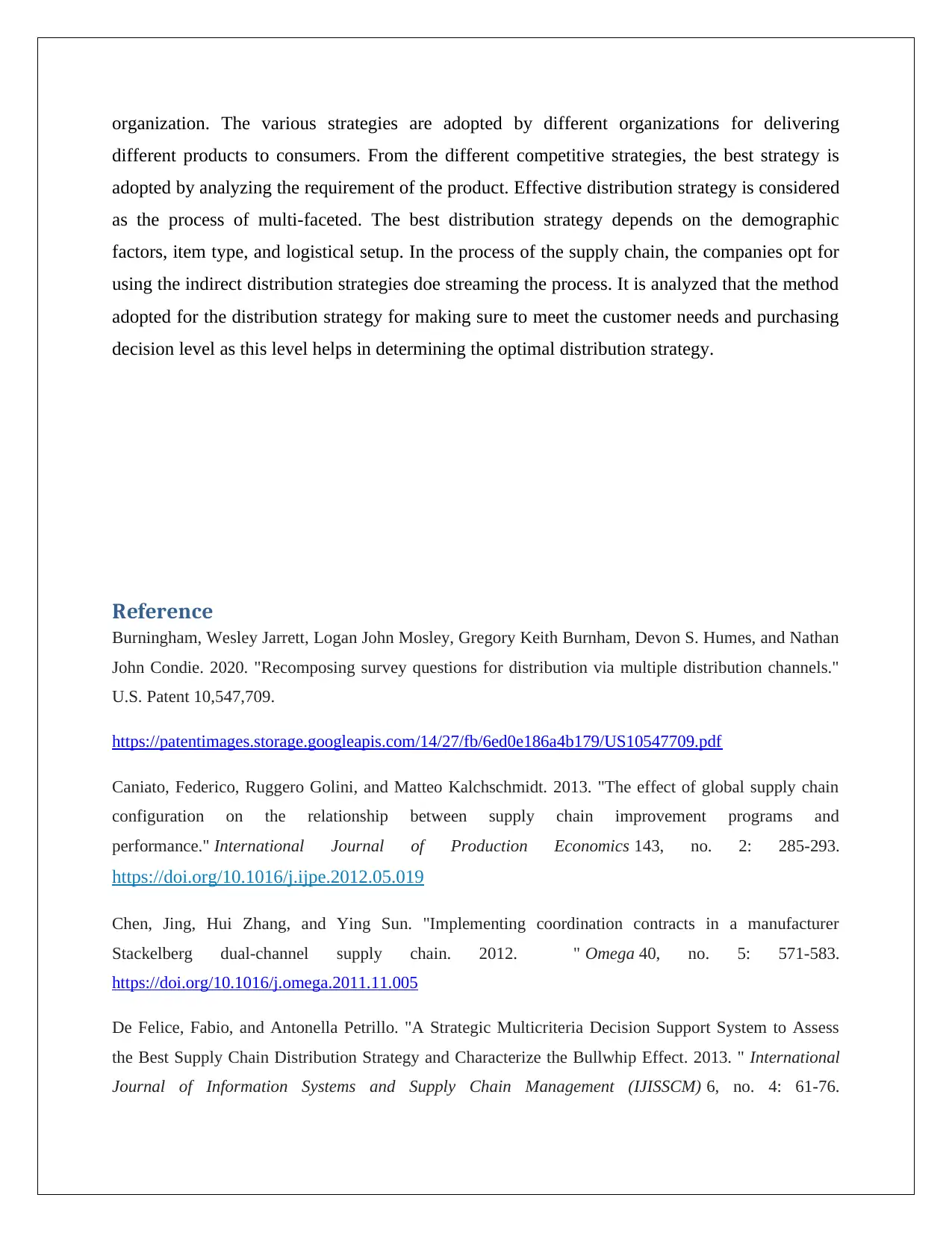
organization. The various strategies are adopted by different organizations for delivering
different products to consumers. From the different competitive strategies, the best strategy is
adopted by analyzing the requirement of the product. Effective distribution strategy is considered
as the process of multi-faceted. The best distribution strategy depends on the demographic
factors, item type, and logistical setup. In the process of the supply chain, the companies opt for
using the indirect distribution strategies doe streaming the process. It is analyzed that the method
adopted for the distribution strategy for making sure to meet the customer needs and purchasing
decision level as this level helps in determining the optimal distribution strategy.
Reference
Burningham, Wesley Jarrett, Logan John Mosley, Gregory Keith Burnham, Devon S. Humes, and Nathan
John Condie. 2020. "Recomposing survey questions for distribution via multiple distribution channels."
U.S. Patent 10,547,709.
https://patentimages.storage.googleapis.com/14/27/fb/6ed0e186a4b179/US10547709.pdf
Caniato, Federico, Ruggero Golini, and Matteo Kalchschmidt. 2013. "The effect of global supply chain
configuration on the relationship between supply chain improvement programs and
performance." International Journal of Production Economics 143, no. 2: 285-293.
https://doi.org/10.1016/j.ijpe.2012.05.019
Chen, Jing, Hui Zhang, and Ying Sun. "Implementing coordination contracts in a manufacturer
Stackelberg dual-channel supply chain. 2012. " Omega 40, no. 5: 571-583.
https://doi.org/10.1016/j.omega.2011.11.005
De Felice, Fabio, and Antonella Petrillo. "A Strategic Multicriteria Decision Support System to Assess
the Best Supply Chain Distribution Strategy and Characterize the Bullwhip Effect. 2013. " International
Journal of Information Systems and Supply Chain Management (IJISSCM) 6, no. 4: 61-76.
different products to consumers. From the different competitive strategies, the best strategy is
adopted by analyzing the requirement of the product. Effective distribution strategy is considered
as the process of multi-faceted. The best distribution strategy depends on the demographic
factors, item type, and logistical setup. In the process of the supply chain, the companies opt for
using the indirect distribution strategies doe streaming the process. It is analyzed that the method
adopted for the distribution strategy for making sure to meet the customer needs and purchasing
decision level as this level helps in determining the optimal distribution strategy.
Reference
Burningham, Wesley Jarrett, Logan John Mosley, Gregory Keith Burnham, Devon S. Humes, and Nathan
John Condie. 2020. "Recomposing survey questions for distribution via multiple distribution channels."
U.S. Patent 10,547,709.
https://patentimages.storage.googleapis.com/14/27/fb/6ed0e186a4b179/US10547709.pdf
Caniato, Federico, Ruggero Golini, and Matteo Kalchschmidt. 2013. "The effect of global supply chain
configuration on the relationship between supply chain improvement programs and
performance." International Journal of Production Economics 143, no. 2: 285-293.
https://doi.org/10.1016/j.ijpe.2012.05.019
Chen, Jing, Hui Zhang, and Ying Sun. "Implementing coordination contracts in a manufacturer
Stackelberg dual-channel supply chain. 2012. " Omega 40, no. 5: 571-583.
https://doi.org/10.1016/j.omega.2011.11.005
De Felice, Fabio, and Antonella Petrillo. "A Strategic Multicriteria Decision Support System to Assess
the Best Supply Chain Distribution Strategy and Characterize the Bullwhip Effect. 2013. " International
Journal of Information Systems and Supply Chain Management (IJISSCM) 6, no. 4: 61-76.
⊘ This is a preview!⊘
Do you want full access?
Subscribe today to unlock all pages.

Trusted by 1+ million students worldwide
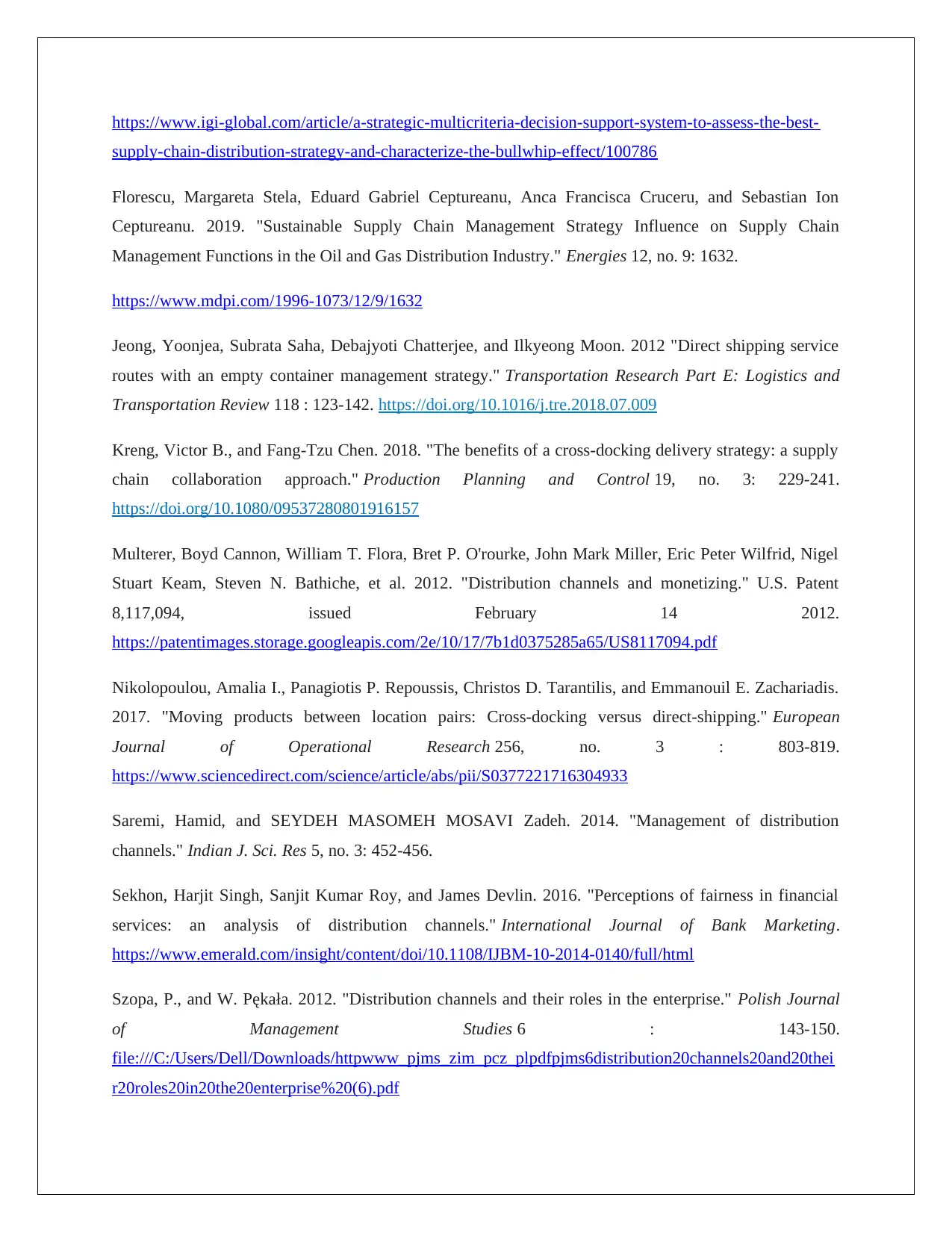
https://www.igi-global.com/article/a-strategic-multicriteria-decision-support-system-to-assess-the-best-
supply-chain-distribution-strategy-and-characterize-the-bullwhip-effect/100786
Florescu, Margareta Stela, Eduard Gabriel Ceptureanu, Anca Francisca Cruceru, and Sebastian Ion
Ceptureanu. 2019. "Sustainable Supply Chain Management Strategy Influence on Supply Chain
Management Functions in the Oil and Gas Distribution Industry." Energies 12, no. 9: 1632.
https://www.mdpi.com/1996-1073/12/9/1632
Jeong, Yoonjea, Subrata Saha, Debajyoti Chatterjee, and Ilkyeong Moon. 2012 "Direct shipping service
routes with an empty container management strategy." Transportation Research Part E: Logistics and
Transportation Review 118 : 123-142. https://doi.org/10.1016/j.tre.2018.07.009
Kreng, Victor B., and Fang-Tzu Chen. 2018. "The benefits of a cross-docking delivery strategy: a supply
chain collaboration approach." Production Planning and Control 19, no. 3: 229-241.
https://doi.org/10.1080/09537280801916157
Multerer, Boyd Cannon, William T. Flora, Bret P. O'rourke, John Mark Miller, Eric Peter Wilfrid, Nigel
Stuart Keam, Steven N. Bathiche, et al. 2012. "Distribution channels and monetizing." U.S. Patent
8,117,094, issued February 14 2012.
https://patentimages.storage.googleapis.com/2e/10/17/7b1d0375285a65/US8117094.pdf
Nikolopoulou, Amalia I., Panagiotis P. Repoussis, Christos D. Tarantilis, and Emmanouil E. Zachariadis.
2017. "Moving products between location pairs: Cross-docking versus direct-shipping." European
Journal of Operational Research 256, no. 3 : 803-819.
https://www.sciencedirect.com/science/article/abs/pii/S0377221716304933
Saremi, Hamid, and SEYDEH MASOMEH MOSAVI Zadeh. 2014. "Management of distribution
channels." Indian J. Sci. Res 5, no. 3: 452-456.
Sekhon, Harjit Singh, Sanjit Kumar Roy, and James Devlin. 2016. "Perceptions of fairness in financial
services: an analysis of distribution channels." International Journal of Bank Marketing.
https://www.emerald.com/insight/content/doi/10.1108/IJBM-10-2014-0140/full/html
Szopa, P., and W. Pękała. 2012. "Distribution channels and their roles in the enterprise." Polish Journal
of Management Studies 6 : 143-150.
file:///C:/Users/Dell/Downloads/httpwww_pjms_zim_pcz_plpdfpjms6distribution20channels20and20thei
r20roles20in20the20enterprise%20(6).pdf
supply-chain-distribution-strategy-and-characterize-the-bullwhip-effect/100786
Florescu, Margareta Stela, Eduard Gabriel Ceptureanu, Anca Francisca Cruceru, and Sebastian Ion
Ceptureanu. 2019. "Sustainable Supply Chain Management Strategy Influence on Supply Chain
Management Functions in the Oil and Gas Distribution Industry." Energies 12, no. 9: 1632.
https://www.mdpi.com/1996-1073/12/9/1632
Jeong, Yoonjea, Subrata Saha, Debajyoti Chatterjee, and Ilkyeong Moon. 2012 "Direct shipping service
routes with an empty container management strategy." Transportation Research Part E: Logistics and
Transportation Review 118 : 123-142. https://doi.org/10.1016/j.tre.2018.07.009
Kreng, Victor B., and Fang-Tzu Chen. 2018. "The benefits of a cross-docking delivery strategy: a supply
chain collaboration approach." Production Planning and Control 19, no. 3: 229-241.
https://doi.org/10.1080/09537280801916157
Multerer, Boyd Cannon, William T. Flora, Bret P. O'rourke, John Mark Miller, Eric Peter Wilfrid, Nigel
Stuart Keam, Steven N. Bathiche, et al. 2012. "Distribution channels and monetizing." U.S. Patent
8,117,094, issued February 14 2012.
https://patentimages.storage.googleapis.com/2e/10/17/7b1d0375285a65/US8117094.pdf
Nikolopoulou, Amalia I., Panagiotis P. Repoussis, Christos D. Tarantilis, and Emmanouil E. Zachariadis.
2017. "Moving products between location pairs: Cross-docking versus direct-shipping." European
Journal of Operational Research 256, no. 3 : 803-819.
https://www.sciencedirect.com/science/article/abs/pii/S0377221716304933
Saremi, Hamid, and SEYDEH MASOMEH MOSAVI Zadeh. 2014. "Management of distribution
channels." Indian J. Sci. Res 5, no. 3: 452-456.
Sekhon, Harjit Singh, Sanjit Kumar Roy, and James Devlin. 2016. "Perceptions of fairness in financial
services: an analysis of distribution channels." International Journal of Bank Marketing.
https://www.emerald.com/insight/content/doi/10.1108/IJBM-10-2014-0140/full/html
Szopa, P., and W. Pękała. 2012. "Distribution channels and their roles in the enterprise." Polish Journal
of Management Studies 6 : 143-150.
file:///C:/Users/Dell/Downloads/httpwww_pjms_zim_pcz_plpdfpjms6distribution20channels20and20thei
r20roles20in20the20enterprise%20(6).pdf
1 out of 10
Related Documents
Your All-in-One AI-Powered Toolkit for Academic Success.
+13062052269
info@desklib.com
Available 24*7 on WhatsApp / Email
![[object Object]](/_next/static/media/star-bottom.7253800d.svg)
Unlock your academic potential
Copyright © 2020–2025 A2Z Services. All Rights Reserved. Developed and managed by ZUCOL.





